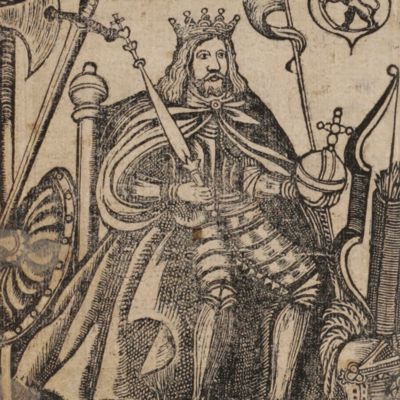Thorgilsson, A. (attr.)
Christendoms Saga Hliodande um þad hvornenn Christen Tru kom fyrst a Island, at forlage þess haloflega Herra. Olafs Tryggvason ar Noregs Kongs.
Skalhollti, Hendrik Kruse, 1688. 8vo (18.0 x 14.7 cm). Title page, frontispiece on verso; [ii] (dedication leaf), 26, [ii] (index) pp. frontispiece portrait of King Olaf; several woodcut initials, and two endpieces. Contemporary (?) limp vellum. All edges red.
History of the introduction of Christianity in Iceland in the tenth century under King Olaf Tryggvason of Norway. Printed in Iceland. Illustrated with frontispiece portrait of the king. Olaf was King of Norway from 995 to 1000. "He was the son of Tryggvi Olafsson, king of Viken (Vingulmark, and Rånrike), and, according to later sagas, the great-grandson of Harald Fairhair, first King of Norway. He is numbered as Olaf I. Olaf was important in the conversion of the Norse to Christianity, but he did so forcibly within his own kingdom. He is said to have built the first Christian church in Norway in 995, and to have founded the city of Trondheim in 997. Historical information on Olaf is sparse. He is mentioned in some contemporary English sources, and some skaldic poems. The oldest narrative source mentioning him briefly is Adam of Bremen's Gesta Hammaburgensis ecclesiae pontificum of circa 1070. In the 1190s, two Latin versions of ' Óláfs saga Tryggvasonar' were written in Iceland, by Oddr Snorrason and Gunnlaugr Leifsson - these are now lost, but are thought to form the basis of later Norse versions. Snorri Sturluson gives an extensive account of Olaf in the Heimskringla saga of circa 1230, using Oddr Snorrason's saga as his primary source. Modern historians do not assume that these late sources are accurate, and their credibility is debated. The most detailed account is named Óláfs saga Tryggvasonar en mesta ('Greatest Saga of Óláfr Tryggvason') and is recorded in the Flateyjarbók, and in the early 15th-century Bergsbók" (Wikipedia). "The story of the consensual conversion of Iceland was first recorded by Ari Thorgilsson in the early 12th century [this work]. Historian Gunnar Karlsson states that Ari Thorgilsson's narration is 'unbelievable, but it is the only one we have'" (Wikipedia). The town of Skálholt no longer exists, largely due to an earthquake in 1784. On its former site, there is only a cathedral, built in the 1960s, and a few cottages. Generally in good condition. Inscribed in an old hand in the lower margin of the title page. Various small imperfections. Restaurations to leaf-edges. Fiske p. 331; Klose 5485; Liddlerdale, T. (1885) Catalogue of the Books Printed in Iceland, from A. D. 1578 to 1880; Stevens, H. (1862) Bibliotheca Americana or A Descriptive Account of My Collection of Rare Books Relating to America, p. 142.




